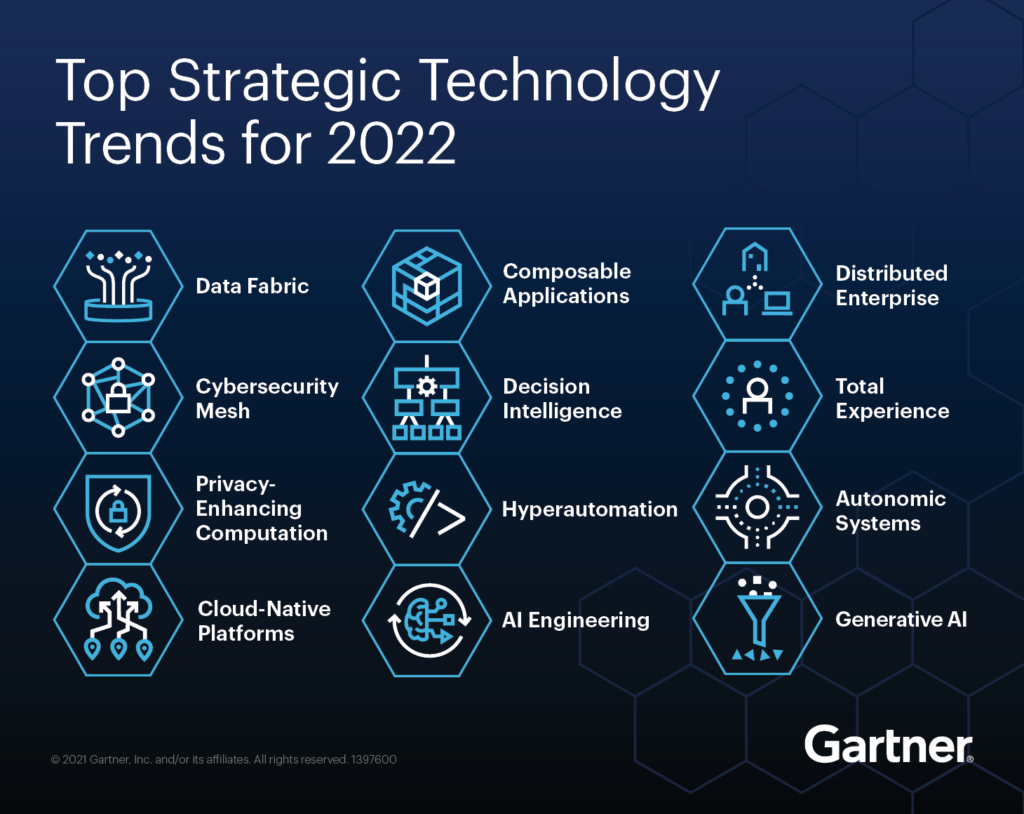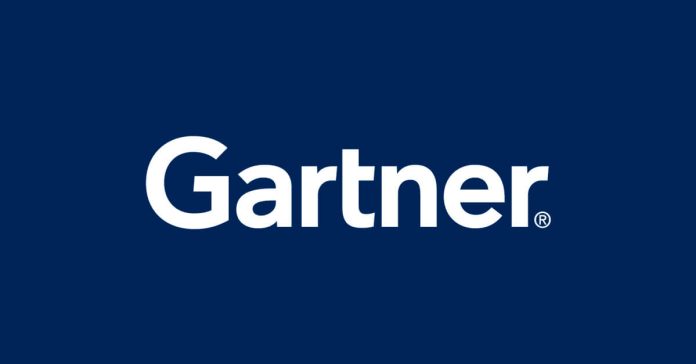Gartner, Inc. reveals hot technology trends that businesses must watch and study to cope with the changes in the coming year. Most also focus on information systems (DATA) for the development of new technologies. Safety and comfort of living
The hottest strategic technology trends of 2022 are:
Reborn Artificial Intelligence [Generative Artificial Intelligence (AI)]
One of the most well-known and powerful AI development techniques that is coming to the market is Generative AI, which is machine learning that learns about content or data objects and uses them to innovate, including: New products that are original and realistic.
Generative AI can be used for activities such as creating software code. Accelerating the drug development process and targeted marketing, however, it has also been found to be inappropriately used, for example, to infringe on the intellectual property of others. Identity forgery, fraud, fraud, political disinformation, and more. Gartner predicts that by 2025, Generative AI will account for 10% of all data generated. higher than current with less than 1% volume
data network [Data Fabric]
The amount of data and silo applications has increased over the past decade. While the number of personnel with skills in Data and Analytics (D&A) has remained stable or decreased.
Data Fabric, a flexible, cross-platform and cross-business data integration technology, was developed to simplify enterprise data integration infrastructure. and build a scalable-ready architecture that solves the technical cumulative problem we call “Technical Debt,” which is common among D&A teams, is largely due to growing data integration challenges.
The real performance of the Data Fabric is its ability to dynamically improve the use of data with its own built-in analytics. Up to 70% of the complexity of data handling is reduced, helping to make the most of your time.

Distributed organization [Distributed Enterprise]
With the increasing number of remote and hybrid working models today. Similarly, organizations that used to focus on office-centric work are shifting to distributed enterprises that support more flexible working models. and allow employees to work both in the office and off-site
Groombridge said, “This shift requires IT executives to make critical adjustments to techniques and services to deliver a seamless work experience. However, a coin always has two sides. Because such work patterns may affect the business model. whether any organization From retail to educational organizations that need to adjust their strategies and create new experiences to support this distributed model. Because the whole world has never expected that in just two years, we will have to switch from trying on clothes in stores to trying them digitally.”
Gartner predicts that by 2023, 75% of organizations leveraging the distributed work experience will earn faster, growing 25% faster than their competitors.
Cloud-Native Platforms (CNPs)
to deliver true digital capabilities from anywhere. Organizations need to ditch the traditional work transfer strategy. “Lifting and Transforming” into CNPs, deploying CNPs leverages the core capabilities of cloud computing to create “As A Service” services, enhancing IT systems’ capabilities. Flexible and scalable for technology companies using Internet technology. as well as adding value by delivering products and services to markets and consumers faster while reducing costs at the same time
Gartner predicts that by 2025, Cloud-Native platforms will serve as the core technology underlying up to 95% of innovation or new digital tools, up from less than 40% in 2021.
More automation (Autonomic Systems)
As the organization grows Traditional programming or old automation may not be the solution. Autonomic Systems are physical systems or software systems that can manage and learn the operating environment on their own. Unlike general automation or automation that does not require human control (Autonomous System), Autonomic Systems can dynamically modify its own algorithms. No external software updates are required. This makes it possible to quickly adapt to new conditions or changes. in the same way that humans can
“Autonomic systems are widely deployed today in complex security environments. But in the long run, this system will become commonplace in tangible ways, such as robots, drones, and manufacturing machines. and smart spaces,” said Groombridge.
smart decision [Decision Intelligence (DI)]
An organization’s decision-making ability is even more essential. Because it is an important strategic resource that can create a competitive advantage for the organization.
Solutions that increase decision intelligence (Decision Intelligence) are practical guidelines to increase decision-making capacity through insight. including the design of decision-making methods and evaluate results, manage and improve from feedback. Gartner predicts that over the next two years, a third of large enterprises will use intelligent decision-making as a decision-making structure to increase their competitive advantage.
Composable Applications
in a constantly changing business context. The need for business adaptation will lead organizations to a technology architecture that supports the transformation of a fast-paced application development model. safe and effective The modular application architecture (or Composable application architecture) enhances the adaptability. And businesses adopting this approach are 80% ahead of competitors in the speed of bringing new features to consumers.
“Throughout the outbreak that caused chaos Flexible business principles can help organizations cope with rapidly changing situations. This is essential for flexibility and business growth. without this Modern organizations risk losing market momentum and customer loyalty,” said Groombridge.
Super automation tools [Hyperautomation]
Hyperautomation Help your business grow quickly and flexibly with the ability to translate results. Optimize audits quickly and automate the processes as much as possible.
“Gartner’s research suggests that the team Hyperautomation High efficiency focuses on three main areas: 1. Improving the quality of work. Business technologists also supported an average of 4.2 automation initiatives in the past year,” said Groombridge.
optimize privacy processor [Privacy-Enhancing Computation (PEC)]
Due to the increasing promulgation of international privacy and data protection laws It is therefore the duty of the management to maintain the trust of customers that may arise from privacy concerns. Gartner estimates that 60% of large enterprises will use at least one data processing technique to enhance privacy by 2025.
PEC is a technique for protecting personal and sensitive information. It covers protection at the software or hardware level of data, securely sharing, collecting, and analyzing data while maintaining privacy compliance. The technique is now being applied in many organizations from different industries. The same is true for public cloud infrastructures (e.g., trusted operational environments).
cyber security net [Cybersecurity Mesh]
Groombridge said, “This year, in addition to the continuous increase in data volume, Data is still a trend that has been discussed throughout the year. But data is only useful when organizations are able to use it with accuracy and precision. Today, assets and users are scattered everywhere. This means that we can no longer use traditional forms of security, relying on an architecture that protects and manages cyberthreats in a mesh or. Cybersecurity Mesh Architecture (CSMA)”
CSMA provides an integrated security structure and approach to keep all assets safe. Regardless of the source of their assets, by 2024, organizations adopting CSMA will integrate their tools and security systems to enable them to function as a participatory ecosystem, helping to reduce the financial impact of cybersecurity incidents. Personal safety can be averaged up to 90%.
engineering artificial intelligence [AI Engineering]
IT leaders struggle with integrating AI into their applications. This wastes time and money on AI projects that never go into production. or trying to maintain the quality of AI solutions at launch, where AI Engineering is an integrated approach for operating different types of AI models.
Groombridge said, “For fusion teams working in AI, the real differentiator for organizations is their ability to continuously add value through rapid AI transformation. By 2025, It found that 10% of organizations creating AI engineering best practices generate at least triple the value of their AI adoption efforts, or more than 90% of organizations that do not.”
full experience [Total Experience (TX)]
TX is a business strategy that combines customer experience (CX), employee experience (EX), user experience (UX), and multiple experiences. With Multiexperience (MX) together, the goal of the TX Strategy is to create more confidence, satisfaction, loyalty and support from customers and employees who are satisfied with the enhanced experience. At the same time, organizations can increase revenue and profit by achieving TX’s adaptive and flexible business effectiveness.



